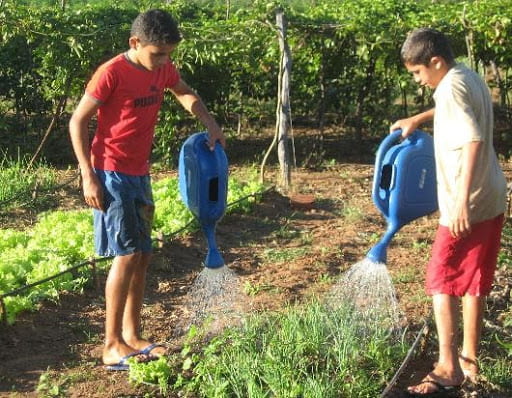It is nearly impossible to have a successful garden without watering. There may be times when the perfect amount of rain falls, but nearly every growing season brings a stretch of hot and dry days when garden irrigation is essential.
Under drought stress, plants may produce small fruit, such as undersized tomatoes or melons, or they may produce no fruit at all. They may become tough, fibrous, or bitter, as with cabbage and turnips. They may bolt, sending up a flower stalk and stopping growth, as with lettuce and spinach. Or they may wilt and die. For the best and tastiest yield, it is important to pay attention to the watering needs of your plants.
But watering is a no-brainer, right? You simply follow common watering rules like “gardens need 1 inch of water per week” or “water once or twice a week“… that works, doesn’t it? Well, the truth is, when it comes to watering there are no hard and fast rules that apply in all situations.
Here are some factors to consider when deciding when to water:
- The life stage of the plant
- Is it germinating? a seedling? A new transplant? Mature? Bearing fruit? Germinating seeds need constant moisture whereas maturing plants do not.
- The soil type
- Sandy? Clay? Loam? They each absorb and maintain water differently.
- The container size
- Is it a large or small container? A raised bed? An in-ground garden? Soil in containers dries out more quickly than the ground.
- The weather
- Has it rained recently and how much? Is it hot or cool or windy? Hot dry weather or windy weather causes more evaporation which dries soil quicker. Humidity has the opposite effect.
- The time of year
- Is it Spring, Summer or Fall? Watering needs are lower in Spring and Fall when it is cooler and higher in Summer.
Don’t let all these factors overwhelm you. They are considerations for deciding when to water and as you gain gardening experience the decision about when to water will become second nature.

Fortunately for new gardeners, there is an easy way to figure out when to water by checking the soil moisture and considering the plant. Just stick your finger in the soil and check the depth until you get to moist soil, then consider the life stage of the plant and follow these general guidelines:
- Germinating seeds and young seedlings should be kept moist. Water gently as soon as you see drying on the surface of the soil.
- As plants grow, slowly reduce water. The top bit of soil should dry so plants develop good root growth below. Young plants and transplants should be watered if the moisture in the soil is down to your first knuckle, about 1”.
- For more mature plants you can go to the second knuckle, about 2”. This is a good general guideline, but keep in mind that some vegetables that produce watery fruits (such as tomatoes and melons) can benefit from extra water at the time they are producing those fruits.
- The soil in containers dries out faster than the ground so use your first knuckle as a guide for container-grown plants.
Here are 5 tips to help you water efficiently and effectively:
- Water early in the morning. That’s when the sunlight is weakest, the ground is coolest and foliage will have hours to dry before nightfall. It’s more difficult for plant diseases to get a foothold when the foliage is dry. Watering in the morning also reduces evaporation. Late afternoon is okay, provided you keep the foliage from getting wet.
- Water deeply and thoroughly. This is important. Deep, less frequent watering encourages deeper and stronger root growth. Soaking the soil to a depth of 5 to 6 inches encourages plants to grow deeper roots, which in the long run will make for a healthier garden.
- Focus the water on the root zone. The key is to ensure that water gets to the root zone – whether you are tending seedlings, watering houseplants, watering a row of tomatoes or soaking thirsty shrubs and trees. Remember that it’s the roots that need access to water, not the leaves. You’ll lose less water to evaporation and by keeping leaves dry you won’t encourage fungal growth.
- Water only when needed. Too much water can be detrimental to plants. Roots take in oxygen from the soil to survive. When the ground is saturated there is little or no oxygen available.
- Mulch beds and containers. Though not exactly a tip for watering, mulch helps soil retain moisture by slowing evaporation, keeping soil cooler, reducing surface runoff and helping to deter weeds.
Here’s hoping for some rain throughout the summer, and for a bountiful harvest and beautiful blooms!
If you’re in St. Lawrence County, contact our Growline for gardening advice at SLCGrowline@gmail.com. Our Master Gardener Volunteers will happily answer your questions.
